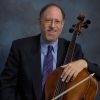
The Joy of Feuillard – A Sequential Approach to Teaching Bow Technique (Part 28 – Feuillard No. 35 – Variations #42-51)
Robert Jesselson
Today’s Blog will deal with Feuillard No. 35, Variations #42 – #51, which all deal with legato string crossings using the upper arm and the wrist/fingers. As we started working on these variations I first reminded Zach about the Seven Arm Levels that we had discussed earlier (the four open strings and the three double stops), and we reviewed the “Seven Arm Level Exercise”. Then I explained how these variations will involve a combination of the various arm levels and the use of the wrist/fingers to go between the double-stop levels.
So, the model for these next variations is #45 – using the upper arm on the double stop level, and the wrist moving between the two strings. I often have the students play Variation #45 before the others because it is somewhat more straightforward in figuring out how to use the arm versus the wrist/fingers.
Variation #45:

Needless to say, all of these string crossings are works-in-progress for evenness, consistency, ease of playing, etc. This is something that we string players work on for our entire lives!
Variation #42:
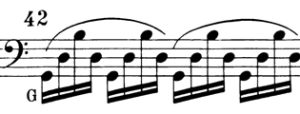
There are several ways to think about the combination of arm levels vs. wrist/fingers on each of these variations, but I feel that the best one for #42 is to think of the arm going to the G-string level, the D-string level, and then the D-A string double-stop level, with the wrist moving between the two upper strings.
I had to work with Zach on using the wrist to go upwards towards the A-string. Students often find it easier to go down to the lower string, and more difficult at first to go up to the higher string. But with some practice that becomes easier. I also had to remind Zach to watch his bow angle on the upbows (that was the motion I made while he was playing).
Variations #43 and #44:


So by the next lesson his string crossings were starting to become a little smoother and the wrist motion was becoming more wave-like. For several of these variations I asked Zach to play the open strings first in order to make sure that he was using the arm correctly for some of the string crossings versus using the wrist/fingers for others.
Variation #46 – #51:


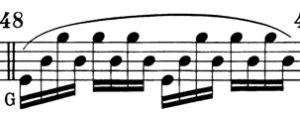
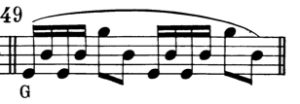
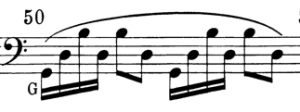

For these variations I will only show a few measures, since they are all so similar. However, each variation calls for a slightly different choreography of the upper arm versus the wrist/fingers. For example, #46 would use two double-stop arm levels, with the wrist going between the G-D string arm level and the D-A string arm level. #49 would use the G-D double-stop string arm level for the 16th notes (with the wrist going between the two strings), and then the A-string arm level followed by the D-string arm-level. It is always useful to play the open strings to work out the arm levels and the evenness of the string crossings before adding in the left hand.
Next week’s Blog will present the final variations of Feuillard No. 35, dealing with a heavy, brushy off-the-string stroke and three-note chords.
*If you have questions or comments about The Joy of Feuillard, Dr. Robert Jesselson can be reached directly at rjesselson@mozart.sc.edu.
Subjects: Repertoire, Technique
Tags: Feuillard, fingers, legato, string crossings, The Joy of Feuillard, upper arm, wrist
